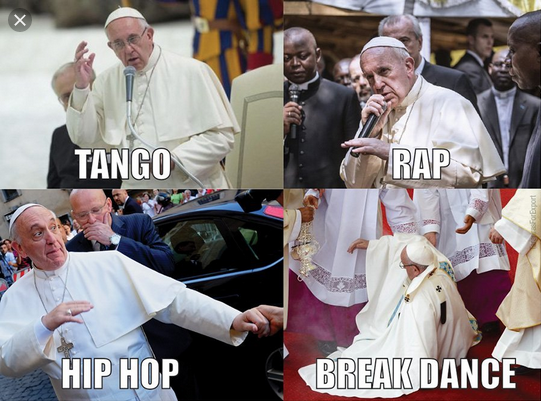
Outtakes that somehow didn’t make it into the movie
Just read the review of “The Two Popes”. . . a “holiday-season bon-bon that humanizes its subjects decorously”.
From the write-up, you can bet it does . . . though it seems to “humanize” one more so than the other.
And surprise! surprise! Guess which Pope benefits most from this Hollywood-contrived all out ‘sales job’ none other than one Jorge Mario Bergoglio . . . known by some as Pope Francis I
Judging from the film review by Joe Morgenstern in Friday’s Wall Street Journal, the Vatican’s public relations dept. couldn’t have done a more extravagant ‘puff piece’ of a movie than this one.
Morganstern even concedes that the film, “at first”, seems “heavily loaded in favor of Bergoglio and gentle liberalism” (from the critic’s account it appears that it is not just “at first” but rather completely throughout, this is a story of how wonderful Pope Francis is, and apparently, how “gentle” his ‘liberal’ agenda for the Church really is. Consider this excerpt:
“Mr. Pryce (as Pope Francis) gives his character the warmth of a furnace fired by concern for ordinary people more than dogmatic faith, while the script foreshadows some of what we know of the current pope. This unassuming prince of the church has an infectious laugh; rolls his own rollaboard on and off commercial flights; rejoices in tango, pizza and soccer; whistles “Dancing Queen” in a men’s room in the Vatican. He insists that the church must deal with the scourge of clerical abuse.”
Still, Morganstern insists,
“the film is neither hagiography nor hatchet job. Bergoglio is no saint. The baggage he carries includes accusations of a close association with a brutally repressive military junta that ruled his country from 1976 to 1983. “I’m still seen as a divisive figure in Argentina…”
(Our observation, admittedly colored by our own general dislike for the current Pope, is that at least in Morgenstern’s account of the film, the examples of Pope Benedict’s base of “popularity” is pretty thin.)
Lest his review that strongly paints Bergoglio as the slightly flawed heroic figure of the story and Benedict as the stuffy, arch conservative, who “sees change as compromise resulting from weakness’, and who “deplores everything about the ‘rumpled, genial” Bergoglio, turns off potential ticket-buyers, Mr. Morgenstern concludes with, “but the film plays the truly magic trick of bringing these firmly entrenched antagonists together as friends—old men who share a tragic sense of life, good men who finally do come to reconciliation through fond and spirited debate. “
So, get your ticket now and see this movie. You’ll come out of it looking for the nearest “climate change protest march” to be found, and where you can sign on to the “New Green Deal”! dlh
*********************************************************************************
P.S. Just to help make what we believe is the point of this film, we offer these excerpts. The reader can draw his or her own conclusions:
“Controversial issues are covered with brisk precision—wealth inequality is particularly dear to the Argentine’s heart. One can question the specifics of Benedict’s rationale in reaching out to Bergoglio; it’s an invention that sometimes feels like a contrivance. But the film plays the truly magic trick of bringing these firmly entrenched antagonists together as friends—old men who share a tragic sense of life, good men who finally do come to reconciliation through fond and spirited debate.
 “The story finds room for love—it’s what Bergoglio feels, as a parish priest, for his parishioners; it’s what he once felt for a young woman when he was young too. We’re privy to that in affecting flashbacks to his youth, and to the dark years he spent working, and politicking, in the junta’s shadow. For all its substance and verbal elegance, “The Two Popes” is a grand spectacle—the production was designed by Mark Tildesley and photographed by César Charlone —with an expansive world view. That’s echoed by a soundtrack ranging from the Beatles through Thelonious Monk to Mercedes Sosa, with bandoneon voicings at moments of yearning and strains of “Nobody Knows the Troubles I’ve Seen” accompanying the two men’s visit to an empty Sistine Chapel. It wouldn’t be far-fetched to see the whole film as a love story that ends in a tango.”
“The story finds room for love—it’s what Bergoglio feels, as a parish priest, for his parishioners; it’s what he once felt for a young woman when he was young too. We’re privy to that in affecting flashbacks to his youth, and to the dark years he spent working, and politicking, in the junta’s shadow. For all its substance and verbal elegance, “The Two Popes” is a grand spectacle—the production was designed by Mark Tildesley and photographed by César Charlone —with an expansive world view. That’s echoed by a soundtrack ranging from the Beatles through Thelonious Monk to Mercedes Sosa, with bandoneon voicings at moments of yearning and strains of “Nobody Knows the Troubles I’ve Seen” accompanying the two men’s visit to an empty Sistine Chapel. It wouldn’t be far-fetched to see the whole film as a love story that ends in a tango.”

Known to some as, “Crazy Frank”.